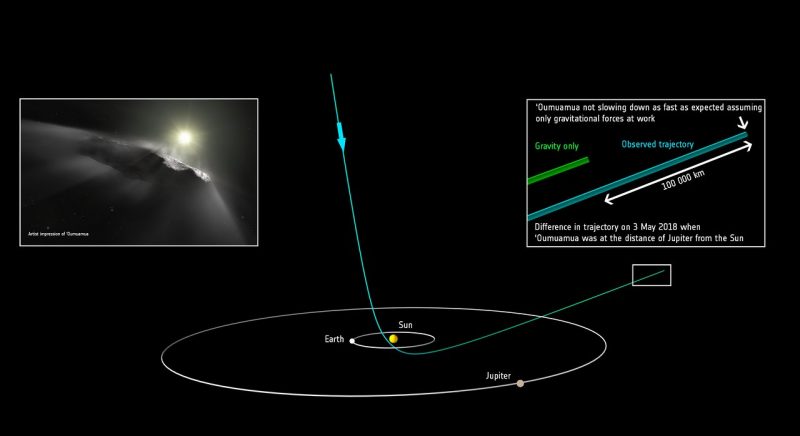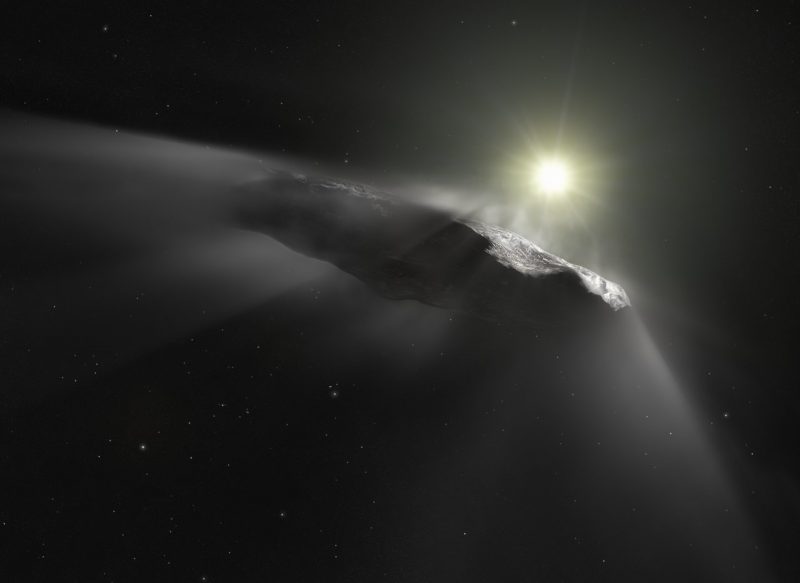Since last October, there’s been big excitement about the first interstellar object discovered passing through our solar system. Astronomers have since suggested that it probably came from a double star system, although we don’t know which one. They say it may have undergone a violent collision, which dislodged it from its own solar system and sent it hurtling our way. Now astronomers have learned something else. They’ve learned that this object – called `Oumuamua, pronounced oh-MOO-ah-MOO-ah – is moving away from the sun faster than expected. The Hubble Space Telescope made the discovery, in cooperation with ground-based telescopes. According to an international team of astronomers:
The new results suggest that `Oumuamua is most likely a comet and not an asteroid.
The astronomers described their new observations and insights on June 27, 2018, in the peer-reviewed journal Nature. The data come from the NASA/ESA Hubble Space Telescope, the Canada-France-Hawaii Telescope, ESO’s Very Large Telescope and the Gemini South Telescope.
The measured gain in ‘Oumuamua’s speed is tiny, these astronomers said. Plus, our sun is still trying to drag `Oumuamua back; that is, the sun’s gravity is still slowing down the object, though not as fast as predicted by celestial mechanics. A statement from SpaceTelescope.org said:
Marco Micheli of the European Space Agency led the team that explored several scenarios to explain ‘Oumuamua’s faster-than-predicted speed. The most likely explanation is that `Oumuamua is venting material from its surface due to solar heating – a behavior known as outgassing. The thrust from this ejected material is thought to provide the small but steady push that is sending `Oumuamua hurtling out of the solar system faster than expected – as of June 1, it is traveling about 114,000 kilometers [70,000 miles] per hour.
Such outgassing is a typical behavior for comets and contradicts the previous classification of `Oumuamua as an interstellar asteroid.
Micheli added:
We think this is a tiny, weird comet. We can see in the data that its boost is getting smaller the farther away it travels from the sun, which is typical for comets.
These scientists explained that, usually, when comets are warmed by the sun they eject dust and gas. This material forms a cloud of material — called a coma — around them, as well as the characteristic comet tail. However, the research team could not detect any visual evidence of outgassing. Co-author Karen Meech of the University of Hawaii said:
We did not see any dust, coma or tail, which is unusual. We think that ‘Oumuamua may vent unusually large, coarse dust grains.
The team speculated that perhaps the small dust grains adorning the surface of most comets eroded during `Oumuamua’s journey through interstellar space, with only larger dust grains remaining. A cloud of these larger particles would not be bright enough to be detected by Hubble.

`Oumuamua is a highly mysterious object. Astronomers would love to know where it originated and originally performed the new observations to determine its path more precisely, in hopes they could trace the object back to its parent star system. They weren’t able to make that backwards trace, and, in fact, the recently-detected gain in speed make ‘Oumuamua’s movement more complex, and thus finding its home solar system even more unlikely. Team member Olivier Hainaut of European Southern Observatory in Germany commented:
The true nature of this enigmatic interstellar nomad may remain a mystery.
And, all the while, ‘Oumuamua just keeps on moving outward, away from our sun. Its perihelion – closest point to our sun – was September 9, 2017. It passed the distance of Jupiter’s orbit in early May 2018 and will pass Saturn’s orbit January 2019. It will reach a distance corresponding to Uranus’ orbit in August 2020 and of Neptune in late June 2024. In late 2025 ‘Oumuamua will reach the outer edge of the Kuiper Belt, and then the heliopause — the edge of the solar system — in November 2038.

Bottom line: `Oumuamua is moving faster than expected on its way out of our solar system. A good explanation is that it’s exhibiting comet-like behavior, venting or outgassing material from its surface, which is giving it a small but steady push.
Source: Non-gravitational acceleration in the trajectory of 1I/2017 U1 (‘Oumuamua)
Help EarthSky keep going! Please donate what you can to our annual crowd-funding campaign.











